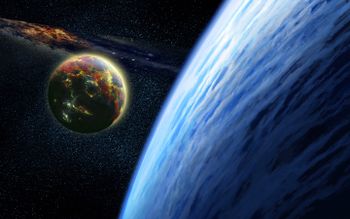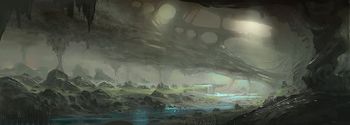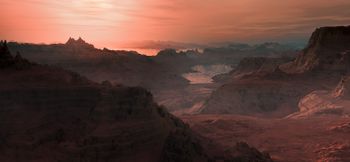Sedantis I
This section or article is a Work in Progress.
Assigned to: LordFowl
Please discuss changes with assigned users. If no one is assigned, or if the user is inactive, feel free to inquire on the Discord as to the status of this page.
Sedantis I was the first moon of the gas giant Sedantis and the origin world of the Vaurcae. It was a desolate and largely lifeless world. While Vaurcae narratives contend that the moon was once verdant, at some point several millennia ago it suffered some great ecological disaster that wiped out most of the alleged life it fostered. Its surface was barren, and bathed constantly in solar radiation due to the weak ozone. The atmosphere of Sedantis I was primarily a mixture of oxygen and gaseous phoron.
The majority of information concerning Sedantis I comes from the recovered records of Vaurcae hives that humanity has encountered, primarily the Zo'ra. The majority of these records are post-Augment Era records of fact, however much information of ancient Sedantis I can only be gleaned from the often poorly kept records and myths of the ancient Pre-Augment Era Vaurcae, records that were more like histories and traditionally disdained by modern Vaurcae. Much of human understanding of this fascinating planet is thus conjecture.
Environment
Atmosphere
The gravity on Sedantis was strong enough to keep a rather substantial atmosphere, which was primarily composed of oxygen and gaseous phoron. The prevailing theory amongst human scientists with a focus on Vaurcae is that the aforementioned ecological disaster was naturally predicated by the volatile mixture of oxygen and phoron, two highly combustible gases. Vaurcae accounts tell of great infernos that would periodically sweep across the land, which contributed heavily to their subterranean society. The natural conclusion reached thus is that the atmosphere eventually burned itself out, allowing the surface to be bathed in the radiation that killed the earth and eventually resulted in the Vaurcae abandoning their world.
The exact science of how a primarily phoron atmosphere came into existence is yet another matter of debate. The temperatures required to vaporize solid phoron on such a massive scale indicates that the world was once rich in solid phoron and underwent great tectonic upheaval. The exact geological history of phoron is relatively unknown, making it difficult to predict whether such a thing could naturally come to be.
The nature of Sedantis' atmospheric conditions made aero-travel and in fact any overground travel difficult, supporting the primarily subterranean lifestyle of its inhabitants and their disinclination toward space travels. Ancient pre Augment Era Vaurcae legends tell of Outsiders - a common character in ancient Vaurcae mythos - vaporizing with beams of heat the foolish hives that attempted to abandon the subterranean lifestyle, which modern xenoarchaeologists interpret as mythological explanations for the natural phenomena of flash phoron fires. Presumably these fires were initiated commonly via electrical discharges such as lightning.
Weather on Sedantis I is a matter of conjecture, as there is a dearth of data concerning the meteorological conditions of the planet. Precipitation was typically in a liquid or more often vaporous state, with heavy, hot, and dense fogs of water rolling across the landscape periodically. Solid precipitation was at best an extremely rare phenomena. Winds and storms were particularly frequent, especially after a phoron fire. The aggressive winds only further made surface dwelling an unattractive prospect.
Lithosphere
To the Vaurcae, the lithosphere - or the first geographic layer of Sedantis I - was of immense importance. The majority of all life on Sedantis dwelt in the massive subterranean caverns, and later the artificial hives of the Vaurcae, that the lithosphere hosted. Serving as the only sure shelter from the hostile surface, the lithosphere was of great mythological significance to ancient Vaurcae, and great pragmatic significance to the modern Vaurcae.
Oceans and major bodies of water on the surface of Sedantis I were virtually non-existent, creating a very uniform lithosphere. The heat of the lithosphere near the surface infrequently approached the heat of the lithosphere as it approached the mantle, making inhabitation near the surface a very risky prospect. The majority of all life dwelt in the middle sections of the lithosphere, in great caverns carved out by unknown geographic forces - perhaps the same forces that vaporized the phoron that contributed to the atmosphere of Sedantis I.
The majority of the lithosphere was composed of metamorphic rock - presumably igneous rocks of the tectonic age of Sedantis I converted by the extreme heat and pressures exerted by the phoron fires of the surface. Sedimentary rock was virtually nonexistent due to the low deposition rates induced by the lack of surface water. The surface was largely homogenized in its mineral variety. However, as one descended the mineral diversity increased exponentially, and many valuable ores were to be found deep beneath the surface, to the benefit of the Vaurcae that dwelt there. Indeed, Sedantis I was the only known world that fostered both sentient life and the invaluable solid phoron deposits that drive the modern economy. Of little practical value to ancient Vaurcae, phoron has nonetheless been a crucial element in their society. Once a subject of almost religious reverence, phoron was nevertheless dug greedily by modern Vaurcae, and was used to fuel their departure from their radiation blasted world. Other minerals such as iron, copper, and platinum were relatively common as well.
The ambient temperature of the subterranean caverns was frequently very hospitable, warmed on both ends by the harsh surface and the heated mantle, the underground served as the perfect kettle for fostering life among all stages of Sedantis' lifetime. Liquid water abounded and oxygen levels were frequently much lower than on the surface, making phoron fires and other dangerous calamities much rarer.
Volcanic activity was relatively frequent in the lower portions of the lithosphere, spurred by the tectonic activity of the mantle. Areas of great volcanic activity were rarely ever settled by ancient or modern Vaurcae, and served as natural borders between hives. Seismic activity was less common, but still a significant danger to early hives, further shaping the development of the "nations" that would dominate modern Vaurcae society.
Fauna
Description of fauna in general.
Placeholder
A possible specimen.
Flora
Description of flora in general.
K'ois
K'ois, or "The Substance", is one of the few flora that is not only survives on Sedantis I, but thrives. It grows
History
An extended history of the moon itself, with minimal discussion of Vaurcae culturally - more discussion in context of the impact they had on Sedantis I.










